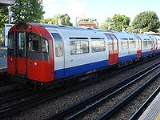
Piccadilly Line
Encyclopedia
The Piccadilly line is a line of the London Underground
, coloured dark blue on the Tube map
. It is the fifth busiest line on the Underground network judged by the number of passengers transported per year. It is mainly a deep-level line, running from the north to the west of London via Zone 1, with a number of surface sections mostly in its westernmost parts. Out of the 53 stations served, 25 are underground. It is the second longest line on the system, after the Central Line
. It is nicknamed as the 'tourist tube' due to many of its stations being surrounded by some of London's top tourist attractions including Harrods
, Hyde Park
, Buckingham Palace
, Piccadilly Circus
(after which the line is named), Leicester Square
and Covent Garden
as well as serving Heathrow Airport, the busiest airport in the world by number of international passengers
.
The Piccadilly line began as the Great Northern, Piccadilly & Brompton Railway (GNP&BR), one of several railways controlled by the Underground Electric Railways Company of London
(UERL), whose chief director was Charles Tyson Yerkes
, although he died before any of his schemes came to fruition.
The GNP&BR was formed from the merger of two earlier, but unbuilt, tube-railway companies taken over in 1901 by Yerkes' consortium: the Great Northern & Strand Railway (GN&SR) and the Brompton & Piccadilly Circus Railway (B&PCR). The GN&SR's and B&PCR's separate routes were linked with an additional section between and . A section of the Metropolitan District Railway
's scheme for a deep-level tube line between and was also added in order to complete the route.
When the GNP&BR was formally opened on 15 December 1906, the line ran from the Great Northern Railway's
station at to the District Railway's station at .
On 30 November 1907, the short branch from Holborn to the Strand (later renamed ) opened, which had been planned as the last section of the GN&SR before the amalgamation with the B&PCR was made. In 1905 (and again in 1965), plans were made to extend it the short distance south under the River Thames
to Waterloo, but this never happened. Although built with twin tunnels, single-line shuttle operation became the norm on the branch from 1918 on, with the eastern tunnel closed to traffic.
, the Charing Cross, Euston and Hampstead Railway) were merged, by private Act of Parliament, to become the London Electric Railway Company.
On 10 December 1928, a rebuilt Piccadilly Circus station was opened. This included a sub-surface booking hall and eleven escalators, replacing the original lifts, and was the start of a considerable renovation of the whole railway, which included a comprehensive programme of station enlargement, on the same basis as the improvements at Piccadilly Circus.

From the 1920s onwards there had been severe congestion at the line's northern terminus, Finsbury Park, where travellers had to change on to trams and buses for destinations in North
and North East London. There had been deputations made to Parliament, asking for an early extension of the line either towards Tottenham
and Edmonton
or towards Wood Green
and Palmers Green
. The early 1930s was a time of recession, and in order to relieve unemployment, government capital was made available. The chief features of the scheme were an extension northwards from Finsbury Park to . It was also planned to build a station between and at the junction of Green Lanes
and St Ann's Road in Harringay
, but this was stopped by Frank Pick
, who felt that the bus and tram service at this point was adequate. However, a 'Ventilation station', in similar architectural style to tube stations of the time was provided at the site, and is visible today. There was also some opposition from the London and North Eastern Railway
to the line. The extension is in tube from Finsbury Park to a point a little south of . The total length of the extension is 12 km (7.5 mi): it cost £4 million to build and was opened in sections as follows:
. By the end of the 1920s the priority had shifted to serving the areas around Hounslow
and north and west of Ealing. The outcome involved taking over the inner pair of tracks between Hammersmith and Acton Town
as a non-stop service, while the Metropolitan District Railway would continue to provide the stopping service on the outer pair of tracks. Construction of the linking sections started in 1930, and the services opened as follows.
These eastward and westward extensions are notable for the Modernist architecture of their new stations, many of them designed by Charles Holden
, who was inspired by examples of Modernist architecture in mainland Europe. This influence can be seen in the bold vertical and horizontal forms, which were combined with the use of traditional materials like brick. Today, many of these Holden-designed station are listed buildings.
, a proposal was put forward to transfer station to the Victoria line, and also to build new "direct" tunnels from Finsbury Park to Turnpike Lane station, thereby cutting the journey time in and out of central London
. This idea was eventually shelved due to the inconvenience to passengers that would have been caused during rebuilding, as well as the costs of the new tunnels. Even so, the Piccadilly line was still affected at Finsbury Park by the construction of the Victoria line. The westbound service was redirected through new tunnels, to give cross-platform interchange
with the Victoria line on the platforms previously used by the Northern City Line
. This work was completed in 1965, and the diversion came into use on 3 October 1965, three years before the opening of the first stage of the Victoria line.
 In 1975, a new tunnel section was opened to from Hounslow West. Hounslow West became a tunnel section station. In 1977, the branch was extended to Heathrow Central. This station was renamed Heathrow Terminals 1, 2, 3 in 1984, with the opening of a one-way loop serving , to the south of the central terminal area.
In 1975, a new tunnel section was opened to from Hounslow West. Hounslow West became a tunnel section station. In 1977, the branch was extended to Heathrow Central. This station was renamed Heathrow Terminals 1, 2, 3 in 1984, with the opening of a one-way loop serving , to the south of the central terminal area.
From 7 January 2005 until 17 September 2006, the loop via Heathrow Terminal 4 was closed to allow the connection of a spur line to the now operational Heathrow Terminal 5 station
. All underground services reverted to two-way working into Terminals 1, 2 and 3, which again became the temporary terminus; shuttle buses served Terminal 4 from the Hatton Cross
bus station. For a brief period in summer 2006, the line terminated at Hatton Cross and shuttle buses also ran to Terminals 1, 2, 3 while the track configuration and tunnels were altered for the Terminal 5 link from that station. The station at Terminal 5 opened on 27 March 2008 on the same day Terminal 5 opened.
Germaine Lindsay
. The blast occurred at 08:50 BST
while the train was between and . It was part of a co-ordinated attack on London's transport network, and was synchronised with three other attacks – two on the Circle line and one on a bus at Tavistock Square
. A small high-explosive device, concealed in a rucksack, was used.
The Piccadilly line bomb resulted in the largest number of fatalities, with 26 people reported killed. Evacuation proved difficult as it is a deep-level line, difficult for the emergency services to reach. Parts of the line re-opened on 8 July, and full service was restored on 4 August, four weeks after the bomb.
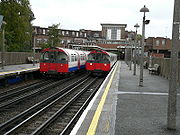 Like virtually all Underground lines, the Piccadilly line is operated by a single type of rolling stock
Like virtually all Underground lines, the Piccadilly line is operated by a single type of rolling stock
, in this case the 1973 tube stock
, in the standard London Underground livery of blue, white and red. Seventy-six trains out of a fleet of 88 are needed to run the line's peak service, and one unit (166-566-366) was severely damaged by the terrorist attack of 7 July 2005. The stock was recently refurbished, and was due for replacement by 2014, but the order for new trains was cancelled in July 2010.
The line was previously worked by 1959 stock
, 1956 stock, 1938 stock
, standard tube stock
and 1906 gate stock
.
The line has two depots, at Northfields and Cockfosters. There are sidings at Oakwood, South Harrow, Arnos Grove, Rayners Lane, Down Street, Wood Green, Acton Town, Ruislip and Uxbridge.
. It is in need of resignalling, and this work was planned to be carried out by 2014, however this has been postponed for financial reasons.
Often late evening services terminate at instead of Cockfosters.
Trains will also make an additional stop at during early mornings and late evenings but will not stop at the station during the main part of the day.
Other services operate at times, especially at the start and towards the end of the traffic day.

.svg.png) opened on 30 November 1907 as the Strand tube station. It was at the end of a branch line from the main line at . An evening through-northbound 'Theatre' train ran until 1910. From 1917 onwards, it was served only by a shuttle from Holborn. In the same year it was renamed Aldwych when Charing Cross on the Northern line was renamed Strand. It was temporarily closed in 1940 during World War II to be used as an air-raid shelter. It re-opened in 1946. The possibility of extending the branch to Waterloo was discussed, but the scheme never proceeded. Aldwych was finally closed on 30 September 1994; the level of use was said to be too low to justify the £1 million in estimated costs of a complete replacement of the lifts. The station is regularly used by film makers.
opened on 30 November 1907 as the Strand tube station. It was at the end of a branch line from the main line at . An evening through-northbound 'Theatre' train ran until 1910. From 1917 onwards, it was served only by a shuttle from Holborn. In the same year it was renamed Aldwych when Charing Cross on the Northern line was renamed Strand. It was temporarily closed in 1940 during World War II to be used as an air-raid shelter. It re-opened in 1946. The possibility of extending the branch to Waterloo was discussed, but the scheme never proceeded. Aldwych was finally closed on 30 September 1994; the level of use was said to be too low to justify the £1 million in estimated costs of a complete replacement of the lifts. The station is regularly used by film makers.
opened 15 December 1906; closed 30 July 1934, between and .
opened 15 December 1906; closed 21 May 1932, between and .
opened 23 June 1903; closed 5 July 1931. Although on the route of the current Piccadilly line, a short distance north of the present station, it was never served by Piccadilly line trains. It was opened by the District line, the original operator of the line between and , and was closed and replaced by the present Park Royal station before the Piccadilly line started running trains to South Harrow in 1932.
opened 15 December 1906; closed 19 September 1932, between and . It has been suggested that this station may be reopened to serve new developments on the nearby Kings Cross
railway lands, but this idea is not being progressed at present. The road the station served, 'York Road', has since been renamed 'York Way
'.
by Transport for London in June 2010, this order was cancelled and the upgrade postponed.
LUL has invited Alstom
, Bombardier
and Siemens
to develop a new concept of lightweight, low-energy, semi-articulated train for the deep-level lines, provisionally called "Evo" (for 'evolution'). So far only Siemens has publicised an outline design, which would feature air-conditioning and would also have battery power enabling the train to run on to the next station if third and fourth rail power were lost. It would have a lower floor and 11% higher passenger capacity than the present tube stock.
There would be a weight saving of 30 tonnes, and the trains would be 17% more energy-efficient with air-conditioning included, or 30% more energy-efficient without it. The intention is that these new trains would eventually operate on the Bakerloo, Central, Piccadilly and Waterloo & City lines.
London Underground
The London Underground is a rapid transit system serving a large part of Greater London and some parts of Buckinghamshire, Hertfordshire and Essex in England...
, coloured dark blue on the Tube map
Tube map
The Tube map is a schematic transit map representing the lines and stations of London's rapid transit railway systems, namely the London Underground , the Docklands Light Railway and London Overground....
. It is the fifth busiest line on the Underground network judged by the number of passengers transported per year. It is mainly a deep-level line, running from the north to the west of London via Zone 1, with a number of surface sections mostly in its westernmost parts. Out of the 53 stations served, 25 are underground. It is the second longest line on the system, after the Central Line
Central Line
The Central line is a London Underground line, coloured red on the tube map. It is a deep-level "tube" line, running east-west across London, and, at , has the greatest total length of track of any line on the Underground. Of the 49 stations served, 20 are below ground...
. It is nicknamed as the 'tourist tube' due to many of its stations being surrounded by some of London's top tourist attractions including Harrods
Harrods
Harrods is an upmarket department store located in Brompton Road in Brompton, in the Royal Borough of Kensington and Chelsea, London. The Harrods brand also applies to other enterprises undertaken by the Harrods group of companies including Harrods Bank, Harrods Estates, Harrods Aviation and Air...
, Hyde Park
Hyde Park, London
Hyde Park is one of the largest parks in central London, United Kingdom, and one of the Royal Parks of London, famous for its Speakers' Corner.The park is divided in two by the Serpentine...
, Buckingham Palace
Buckingham Palace
Buckingham Palace, in London, is the principal residence and office of the British monarch. Located in the City of Westminster, the palace is a setting for state occasions and royal hospitality...
, Piccadilly Circus
Piccadilly Circus
Piccadilly Circus is a road junction and public space of London's West End in the City of Westminster, built in 1819 to connect Regent Street with the major shopping street of Piccadilly...
(after which the line is named), Leicester Square
Leicester Square
Leicester Square is a pedestrianised square in the West End of London, England. The Square lies within an area bound by Lisle Street, to the north; Charing Cross Road, to the east; Orange Street, to the south; and Whitcomb Street, to the west...
and Covent Garden
Covent Garden
Covent Garden is a district in London on the eastern fringes of the West End, between St. Martin's Lane and Drury Lane. It is associated with the former fruit and vegetable market in the central square, now a popular shopping and tourist site, and the Royal Opera House, which is also known as...
as well as serving Heathrow Airport, the busiest airport in the world by number of international passengers
World's busiest airports by international passenger traffic
The following is a list of the world's busiest airports by international passenger traffic.London Heathrow has been the busiest since 2000-2010 year-to-date statistics:Airports Council International's year-to-date figures are as follows....
.
The beginnings
- See Great Northern, Piccadilly and Brompton RailwayGreat Northern, Piccadilly and Brompton RailwayThe Great Northern, Piccadilly and Brompton Railway , also known as the Piccadilly tube, was a railway company established in 1902 that constructed a deep-level underground "tube" railway in London. The GNP&BR was formed through a merger of two older companies, the Brompton and Piccadilly Circus...
for detailed histories of the Great Northern, Piccadilly & Brompton Railway (GNP&BR), the Great Northern & Strand Railway (GN&SR), and the Brompton & Piccadilly Circus Railway (B&PCR).
The Piccadilly line began as the Great Northern, Piccadilly & Brompton Railway (GNP&BR), one of several railways controlled by the Underground Electric Railways Company of London
Underground Electric Railways Company of London
The Underground Electric Railways Company of London Limited , known operationally as The Underground for much of its existence, was established in 1902. It was the holding company for the three deep-level "tube"A "tube" railway is an underground railway constructed in a circular tunnel by the use...
(UERL), whose chief director was Charles Tyson Yerkes
Charles Yerkes
Charles Tyson Yerkes was an American financier, born in Philadelphia. He played a major part in developing mass-transit systems in Chicago and London.-Philadelphia:...
, although he died before any of his schemes came to fruition.
The GNP&BR was formed from the merger of two earlier, but unbuilt, tube-railway companies taken over in 1901 by Yerkes' consortium: the Great Northern & Strand Railway (GN&SR) and the Brompton & Piccadilly Circus Railway (B&PCR). The GN&SR's and B&PCR's separate routes were linked with an additional section between and . A section of the Metropolitan District Railway
Metropolitan District Railway
The Metropolitan District Railway was the predecessor of the District line of the London Underground. Set up on 29 July 1864, at first to complete the "Inner Circle" railway around central London, it was gradually extended into the suburbs...
's scheme for a deep-level tube line between and was also added in order to complete the route.
When the GNP&BR was formally opened on 15 December 1906, the line ran from the Great Northern Railway's
Great Northern Railway (Great Britain)
The Great Northern Railway was a British railway company established by the Great Northern Railway Act of 1846. On 1 January 1923 the company lost its identity as a constituent of the newly formed London and North Eastern Railway....
station at to the District Railway's station at .
On 30 November 1907, the short branch from Holborn to the Strand (later renamed ) opened, which had been planned as the last section of the GN&SR before the amalgamation with the B&PCR was made. In 1905 (and again in 1965), plans were made to extend it the short distance south under the River Thames
River Thames
The River Thames flows through southern England. It is the longest river entirely in England and the second longest in the United Kingdom. While it is best known because its lower reaches flow through central London, the river flows alongside several other towns and cities, including Oxford,...
to Waterloo, but this never happened. Although built with twin tunnels, single-line shuttle operation became the norm on the branch from 1918 on, with the eastern tunnel closed to traffic.
Later changes
On 1 July 1910, the GNP&BR and the other UERL-owned tube railways (the Baker Street and Waterloo RailwayBaker Street and Waterloo Railway
The Baker Street and Waterloo Railway , also known as the Bakerloo tube, was a railway company established in 1893 that constructed a deep-level underground "tube" railway in London...
, the Charing Cross, Euston and Hampstead Railway) were merged, by private Act of Parliament, to become the London Electric Railway Company.
On 10 December 1928, a rebuilt Piccadilly Circus station was opened. This included a sub-surface booking hall and eleven escalators, replacing the original lifts, and was the start of a considerable renovation of the whole railway, which included a comprehensive programme of station enlargement, on the same basis as the improvements at Piccadilly Circus.
Cockfosters extension

From the 1920s onwards there had been severe congestion at the line's northern terminus, Finsbury Park, where travellers had to change on to trams and buses for destinations in North
North London
North London is the northern part of London, England. It is an imprecise description and the area it covers is defined differently for a range of purposes. Common to these definitions is that it includes districts located north of the River Thames and is used in comparison with South...
and North East London. There had been deputations made to Parliament, asking for an early extension of the line either towards Tottenham
Tottenham
Tottenham is an area of the London Borough of Haringey, England, situated north north east of Charing Cross.-Toponymy:Tottenham is believed to have been named after Tota, a farmer, whose hamlet was mentioned in the Domesday Book; hence Tota's hamlet became Tottenham...
and Edmonton
Edmonton, London
Edmonton is an area in the east of the London Borough of Enfield, England, north-north-east of Charing Cross. It has a long history as a settlement distinct from Enfield.-Location:...
or towards Wood Green
Wood Green
Wood Green is a district in north London, England, located in the London Borough of Haringey. It is situated north of Charing Cross. The area is identified in the London Plan as one of the metropolitan centres in Greater London.-History:...
and Palmers Green
Palmers Green
Palmers Green is a place in the London Borough of Enfield. It is a suburban area situated 7.6 miles north of Charing Cross. Postally, it is in London N13...
. The early 1930s was a time of recession, and in order to relieve unemployment, government capital was made available. The chief features of the scheme were an extension northwards from Finsbury Park to . It was also planned to build a station between and at the junction of Green Lanes
Green Lanes
Green Lanes, London, is a main road in North London and forms part of the A105. At approximately 7.5 miles from end to end, it is one of the longest streets in the capital....
and St Ann's Road in Harringay
Harringay
Harringay is a residential area of North London, part of the London Borough of Haringey, United Kingdom. It is centred on the section of Green Lanes running between the northern boundary of Finsbury Park up to the southern boundary of Duckett's Common, not far from Turnpike Lane.-Location:The...
, but this was stopped by Frank Pick
Frank Pick
Frank Pick LLB Hon. RIBA was a British transport administrator. After qualifying as a solicitor in 1902, he worked at the North Eastern Railway, before moving to the Underground Electric Railways Company of London in 1906...
, who felt that the bus and tram service at this point was adequate. However, a 'Ventilation station', in similar architectural style to tube stations of the time was provided at the site, and is visible today. There was also some opposition from the London and North Eastern Railway
London and North Eastern Railway
The London and North Eastern Railway was the second-largest of the "Big Four" railway companies created by the Railways Act 1921 in Britain...
to the line. The extension is in tube from Finsbury Park to a point a little south of . The total length of the extension is 12 km (7.5 mi): it cost £4 million to build and was opened in sections as follows:
- 19 September 1932: to Arnos Grove
- 13 March 1933: to Enfield West (now Oakwood)Oakwood tube stationOakwood is a London Underground station on the Piccadilly Line. It is the second most northerly station on the line, between Southgate and Cockfosters stations, and is in Travelcard Zone 5...
, in conjunction with the westward extension to Hounslow West - 19 July 1933: completion to Cockfosters
Westward extensions
Powers to link with existing tracks west of Hammersmith were originally obtained in 1913. A Parliamentary report of 1919 recommended through running to Richmond and EalingEaling
Ealing is a suburban area of west London, England and the administrative centre of the London Borough of Ealing. It is located west of Charing Cross and around from the City of London. It is one of the major metropolitan centres identified in the London Plan. It was historically a rural village...
. By the end of the 1920s the priority had shifted to serving the areas around Hounslow
Hounslow
Hounslow is the principal town in the London Borough of Hounslow. It is a suburban development situated 10.6 miles west south-west of Charing Cross. It forms a post town in the TW postcode area.-Etymology:...
and north and west of Ealing. The outcome involved taking over the inner pair of tracks between Hammersmith and Acton Town
Acton Town tube station
Acton Town is a London Underground station in Acton, west London, served by the Piccadilly and District lines. The station is at the junction of Gunnersbury Lane and Bollo Lane and is in Travelcard Zone 3.-Services:...
as a non-stop service, while the Metropolitan District Railway would continue to provide the stopping service on the outer pair of tracks. Construction of the linking sections started in 1930, and the services opened as follows.
- to : the District Railway had operated services to Uxbridge since 1910. The District services were taken over by the Piccadilly line:
- 4 July 1932: extended from Hammersmith to
- 23 October 1933 (after formation of the London Passenger Transport BoardLondon Passenger Transport BoardThe London Passenger Transport Board was the organisation responsible for public transport in London, UK, and its environs from 1933 to 1948...
): to Uxbridge
- to Hounslow: the line from was quadrupled to on 18 December 1932 and the Piccadilly line was extended:
- 9 January 1933: to Northfields
- 13 March 1933: to , in conjunction with the eastern extension to Enfield West.
These eastward and westward extensions are notable for the Modernist architecture of their new stations, many of them designed by Charles Holden
Charles Holden
Charles Henry Holden, Litt. D., FRIBA, MRTPI, RDI was a Bolton-born English architect best known for designing many London Underground stations during the 1920s and 1930s, for Bristol Central Library, the Underground Electric Railways Company of London's headquarters at 55 Broadway and for the...
, who was inspired by examples of Modernist architecture in mainland Europe. This influence can be seen in the bold vertical and horizontal forms, which were combined with the use of traditional materials like brick. Today, many of these Holden-designed station are listed buildings.
Victoria line
During the planning stages of the Victoria lineVictoria Line
The Victoria line is a deep-level London Underground line running from the south to the north-east of London. It is coloured light blue on the Tube map...
, a proposal was put forward to transfer station to the Victoria line, and also to build new "direct" tunnels from Finsbury Park to Turnpike Lane station, thereby cutting the journey time in and out of central London
Central London
Central London is the innermost part of London, England. There is no official or commonly accepted definition of its area, but its characteristics are understood to include a high density built environment, high land values, an elevated daytime population and a concentration of regionally,...
. This idea was eventually shelved due to the inconvenience to passengers that would have been caused during rebuilding, as well as the costs of the new tunnels. Even so, the Piccadilly line was still affected at Finsbury Park by the construction of the Victoria line. The westbound service was redirected through new tunnels, to give cross-platform interchange
Cross-platform interchange
A cross-platform interchange is a type of interchange between different lines in a metro system. The term originates with the London Underground; such layouts exist in other networks but are not commonly so named...
with the Victoria line on the platforms previously used by the Northern City Line
Northern City Line
The Northern City Line is a railway line from Moorgate to Finsbury Park in London, once part of the Great Northern Electrics line. It should not be confused with the City branch of the Northern line, nor with the North London Line...
. This work was completed in 1965, and the diversion came into use on 3 October 1965, three years before the opening of the first stage of the Victoria line.
Heathrow extension

From 7 January 2005 until 17 September 2006, the loop via Heathrow Terminal 4 was closed to allow the connection of a spur line to the now operational Heathrow Terminal 5 station
Heathrow Terminal 5 station
Heathrow Terminal 5 station is a shared railway station at London Heathrow Airport Terminal 5 which was opened on 27 March 2008. It was designed by architects HOK International in conjunction with Rogers, Stirk, Harbour & Partners....
. All underground services reverted to two-way working into Terminals 1, 2 and 3, which again became the temporary terminus; shuttle buses served Terminal 4 from the Hatton Cross
Hatton, London
Hatton is a small settlement in the London Borough of Hounslow, on the southern perimeter of London Heathrow Airport and on the A30 road.-Etymology:Hatton's name comes from Anglo-Saxon Hǣþtūn = "heath farmstead".-Neighbours:...
bus station. For a brief period in summer 2006, the line terminated at Hatton Cross and shuttle buses also ran to Terminals 1, 2, 3 while the track configuration and tunnels were altered for the Terminal 5 link from that station. The station at Terminal 5 opened on 27 March 2008 on the same day Terminal 5 opened.
2005 terrorist attack
On 7 July 2005, a Piccadilly line train was attacked by suicide bomberSuicide attack
A suicide attack is a type of attack in which the attacker expects or intends to die in the process.- Historical :...
Germaine Lindsay
Germaine Lindsay
Germaine Maurice Lindsay , also known as Abdullah Shaheed Jamal, was one of the four homegrown terrorists who detonated bombs on three trains on the London Underground and one bus in central London during the 7 July 2005 London bombings, killing 56 people , and injuring more than 700...
. The blast occurred at 08:50 BST
British Summer Time
Western European Summer Time is a summer daylight saving time scheme, 1 hour ahead of Coordinated Universal Time. It is used in the following places:* the Canary Islands* Portugal * Ireland...
while the train was between and . It was part of a co-ordinated attack on London's transport network, and was synchronised with three other attacks – two on the Circle line and one on a bus at Tavistock Square
Tavistock Square
Tavistock Square is a public square in Bloomsbury, in the London Borough of Camden with a fine garden.-Public art:The centre-piece of the gardens is a statue of Mahatma Gandhi, which was installed in 1968....
. A small high-explosive device, concealed in a rucksack, was used.
The Piccadilly line bomb resulted in the largest number of fatalities, with 26 people reported killed. Evacuation proved difficult as it is a deep-level line, difficult for the emergency services to reach. Parts of the line re-opened on 8 July, and full service was restored on 4 August, four weeks after the bomb.
Rolling stock

London Underground rolling stock
The history of the London Underground's rolling stock is as complex as the history of the network itself. A wide variety of types have been operated, from the early days of steam locomotives and carriages through to today's electric multiple units...
, in this case the 1973 tube stock
London Underground 1973 Stock
The 1973 Tube Stock operates on the Piccadilly line of the London Underground and was introduced in 1975 for the opening of the extension to Hatton Cross .-Construction:...
, in the standard London Underground livery of blue, white and red. Seventy-six trains out of a fleet of 88 are needed to run the line's peak service, and one unit (166-566-366) was severely damaged by the terrorist attack of 7 July 2005. The stock was recently refurbished, and was due for replacement by 2014, but the order for new trains was cancelled in July 2010.
The line was previously worked by 1959 stock
London Underground 1959 Stock
The 1959 Tube Stock was a type of London Underground tube train constructed in the late 1950s. They were intended for use on the Piccadilly line, but also saw use on several other tube lines...
, 1956 stock, 1938 stock
London Underground 1938 Stock
The 1938 Tube Stock is a London Underground tube stock design. The trains were built by Metro-Cammell and Birmingham RC&W, and were used on the London Underground until 1988. During their long lives they worked on the Bakerloo, Piccadilly, Northern, East London and Central lines...
, standard tube stock
London Underground Standard Stock
The Standard Stock title was applied to a variety of Tube stock built between 1923 and 1934, all of which shared the same basic characteristics, but with some detailed differences. This design is also sometimes referred to as 1923 Tube Stock or Pre 1938 Stock...
and 1906 gate stock
London Underground 1906 Stock
The 1906 Stock, also known as "Gate Stock", was built for the Yerkes tube lines, Baker Street and Waterloo Railway , Great Northern, Piccadilly and Brompton Railway , and Charing Cross, Euston and Hampstead Railway ....
.
The line has two depots, at Northfields and Cockfosters. There are sidings at Oakwood, South Harrow, Arnos Grove, Rayners Lane, Down Street, Wood Green, Acton Town, Ruislip and Uxbridge.
Signalling
The line is controlled from the control centre at Earl's Court, which it used to share with the District lineDistrict Line
The District line is a line of the London Underground, coloured green on the Tube map. It is a "sub-surface" line, running through the central area in shallow cut-and-cover tunnels. It is the busiest of the sub-surface lines. Out of the 60 stations served, 25 are underground...
. It is in need of resignalling, and this work was planned to be carried out by 2014, however this has been postponed for financial reasons.
Service pattern
The current off-peak service pattern is:- 6 trains per hour – (via Terminals 1, 2, 3)
- 6 trains per hour Cockfosters – (returning around the loop and serving Terminals 1, 2, 3)
- 3 trains per hour Cockfosters –
- 3 trains per hour Cockfosters –
- 6 trains per hour Arnos Grove –
Often late evening services terminate at instead of Cockfosters.
Trains will also make an additional stop at during early mornings and late evenings but will not stop at the station during the main part of the day.
Other services operate at times, especially at the start and towards the end of the traffic day.
Map

Stations
(In order from east to west.)Cockfosters branch
| Cockfosters branch | |||
| Station | Image | Opened | Additional information |
|---|---|---|---|
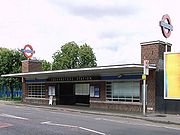 |
31 July 1933 | One of the two depots is located here | |
 |
13 March 1933 | Opened as Enfield West; renamed Enfield West Oakwood 3 May 1934; renamed 1 September 1946 | |
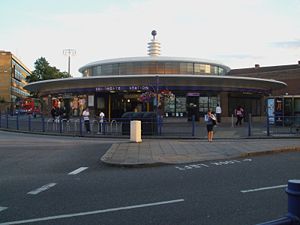 |
13 March 1933 | in deep-level tunnel | |
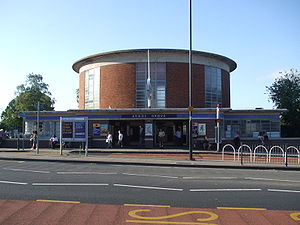 |
19 September 1932 | Trains may terminate here: there are several sidings for stabling trains | |
| Tunnel section commences | |||
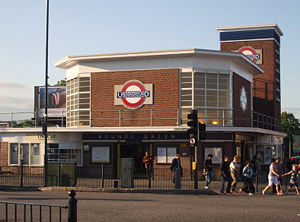 |
19 September 1932 | ||
| 19 September 1932 | |||
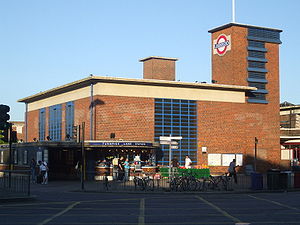 |
19 September 1932 | ||
| 19 September 1932 | |||
| Original Section | |||
 |
15 December 1906 | ||
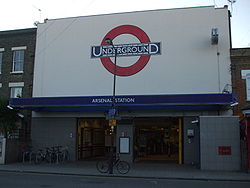 |
15 December 1906 | Opened as Gillespie Road; renamed Arsenal (Highbury Hill) 31 October 1932; the suffix was later dropped in 1960 | |
| 15 December 1906 | |||
| 15 December 1906 | |||
 |
15 December 1906 | Opened as King's Cross; renamed King's Cross for St. Pancras 1927; renamed 1933 | |
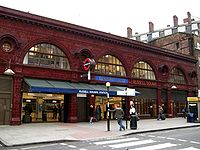 |
15 December 1906 | ||
 |
15 December 1906 | Renamed Holborn (Kingsway) 22 May 1933; the suffix was later dropped. | |
| 11 April 1907 | |||
| 15 December 1906 | |||
| 15 December 1906 | |||
 |
15 December 1906 | Opened as Dover Street; renamed 18 September 1933 | |
| 15 December 1906 | In the event of disruption, trains may terminate here via a crossover | ||
| 15 December 1906 | |||
 |
8 January 1907 | ||
 |
15 December 1906 | ||
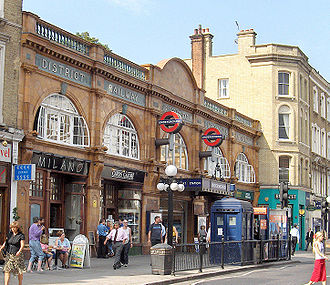 |
15 December 1906 | ||
| Tunnel section ends | |||
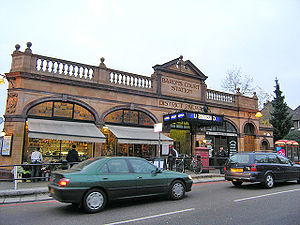 |
15 December 1906 | ||
| 15 December 1906 | |||
Extension to Hounslow and Uxbridge
| Extension to Hounslow and Uxbridge | |||
| Station | Image | Opened | Additional information |
|---|---|---|---|
| 1 January 1869 | Originally the London and South Western Railway London and South Western Railway The London and South Western Railway was a railway company in England from 1838 to 1922. Its network extended from London to Plymouth via Salisbury and Exeter, with branches to Ilfracombe and Padstow and via Southampton to Bournemouth and Weymouth. It also had many routes connecting towns in... ; first served by the Piccadilly line 23 June 1963 |
||
 |
1 July 1879 | Originally the Metropolitan District Railway Metropolitan District Railway The Metropolitan District Railway was the predecessor of the District line of the London Underground. Set up on 29 July 1864, at first to complete the "Inner Circle" railway around central London, it was gradually extended into the suburbs... , later District line District Line The District line is a line of the London Underground, coloured green on the Tube map. It is a "sub-surface" line, running through the central area in shallow cut-and-cover tunnels. It is the busiest of the sub-surface lines. Out of the 60 stations served, 25 are underground... ; first served by the Piccadilly line 4 July 1932 |
|
| The line splits here into two branches – the Heathrow London Heathrow Airport London Heathrow Airport or Heathrow , in the London Borough of Hillingdon, is the busiest airport in the United Kingdom and the third busiest airport in the world in terms of total passenger traffic, handling more international passengers than any other airport around the globe... branch and the Uxbridge Uxbridge Uxbridge is a large town located in north west London, England and is the administrative headquarters of the London Borough of Hillingdon. It forms part of the ceremonial county of Greater London. It is located west-northwest of Charing Cross and is one of the major metropolitan centres... branch. |
|||
Heathrow branch
| Continuing from Acton Town | |||
| Station | Image | Opened | Additional information |
|---|---|---|---|
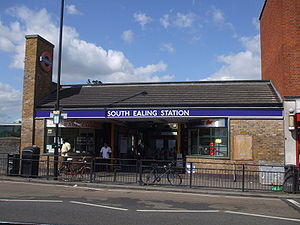 |
1 May 1883 | Originally the Metropolitan District Railway Metropolitan District Railway The Metropolitan District Railway was the predecessor of the District line of the London Underground. Set up on 29 July 1864, at first to complete the "Inner Circle" railway around central London, it was gradually extended into the suburbs... , later District line District Line The District line is a line of the London Underground, coloured green on the Tube map. It is a "sub-surface" line, running through the central area in shallow cut-and-cover tunnels. It is the busiest of the sub-surface lines. Out of the 60 stations served, 25 are underground... ; first served by the Piccadilly line 29 April 1935 |
|
| 16 April 1908 | Originally the District line (one of the two depots is here and some trains terminate here); first served by the Piccadilly line 9 January 1933 | ||
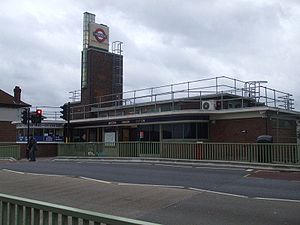 |
1 May 1883 | Originally the District line; first served by the Piccadilly line 13 March 1933 | |
| 23 March 1934 | |||
| 2 May 1909 | Opened as Hounslow Town by the District line renamed 1 December 1925; first served by the Piccadilly line 13 March 1933 | ||
| 1 April 1886 | Opened as Heston-Hounslow by the District line, renamed 1 December 1925; first served by the Piccadilly line 13 March 1933 | ||
| Tunnel section recommences | |||
| 21 July 1884 | Opened as Hounslow Barracks) by the District line, renamed 1 December 1925; first served by the Piccadilly line 13 March 1933, resited 19 July 1975 | ||
 |
19 July 1975 | ||
 |
12 April 1986 | ||
 |
16 December 1977 | Opened as Heathrow Central; renamed Heathrow Central Terminals 1,2,3 on 3 September 1983; renamed 12 April 1986 | |
 |
27 March 2008 | ||
| Just beyond Heathrow Terminals 1, 2, 3 tube station, the line goes into a new section to serve Heathrow Terminal 5 tube station Heathrow Terminal 5 station Heathrow Terminal 5 station is a shared railway station at London Heathrow Airport Terminal 5 which was opened on 27 March 2008. It was designed by architects HOK International in conjunction with Rogers, Stirk, Harbour & Partners.... , which opened in March 2008. Half of all Heathrow trains use the loop and serve Terminal 4 and the other half omit Terminal 4 and serve Terminal 5. |
|||
Uxbridge branch
| Continuing from Acton Town | |||
| Station | Image | Opened | Additional information |
|---|---|---|---|
| 1 July 1879 | Originally the District line; first served by the Piccadilly line 4 July 1932 | ||
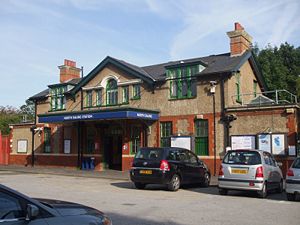 |
23 June 1903 | Originally the District line; first served by the Piccadilly line 4 July 1932 | |
| 6 July 1931 | Originally the District line; first served by the Piccadilly line 4 July 1932; renamed Park Royal (Hanger Hill) 1 March 1936; renamed 1947 | ||
| 28 June 1903 | Opened as Perivale-Alperton by the District line; renamed 7 October 1910; first served by the Piccadilly line 4 July 1932 | ||
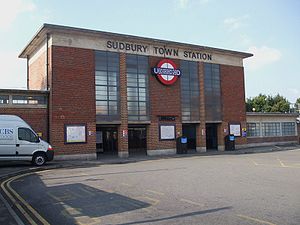 |
28 June 1903 | Originally the District line; first served by the Piccadilly line 4 July 1932 | |
| ( ) | 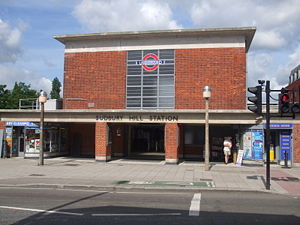 |
28 June 1903 | Originally the District line; first served by the Piccadilly line 4 July 1932 |
| 28 June 1903 | Originally the District line; first served by the Piccadilly line 4 July 1932; closed when re-located 4 July 1935; re-opened 5 July 1935 | ||
 |
1 March 1910 | Originally the District line; first served by the Piccadilly line 23 October 1933 (from here to Uxbridge trains share track with Metropolitan line Metropolitan Line The Metropolitan line is part of the London Underground. It is coloured in Transport for London's Corporate Magenta on the Tube map and in other branding. It was the first underground railway in the world, opening as the Metropolitan Railway on 10 January 1863... , and some trains terminate here) |
|
 |
1 March 1910 | Originally the District line; first served by the Piccadilly line 23 October 1933 | |
 |
5 August 1912 | Originally the District line; first served by the Piccadilly line 23 October 1933 | |
 |
1 March 1910 | Originally the District line; first served by the Piccadilly line 23 October 1933 (some trains terminate here in Monday-Friday peak hours) | |
| 1 March 1910 | Originally the District line; first served by the Piccadilly line 23 October 1933 | ||
 |
10 December 1923 | Originally the District line; first served by the Piccadilly line 23 October 1933; renamed Hillingdon (Swakeleys) April 1934; the suffix was later dropped; closed when re-located 5 December 1992; re-opened 6 December 1992 | |
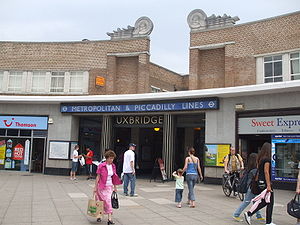 |
1 March 1910 | Terminus. Originally the District line; first served by the Piccadilly line 23 October 1933; closed when re-located 3 December 1938; re-opened 4 December 1938 | |
Closed stations
.svg.png)
opened 15 December 1906; closed 30 July 1934, between and .
opened 15 December 1906; closed 21 May 1932, between and .
- Osterley & Spring GroveOsterley tube stationOsterley is a London Underground station in Osterley in west London. The station is on the Heathrow branch of the Piccadilly Line, between Boston Manor and Hounslow East. The station is located on Great West Road close to the National Trust-owned Osterley Park. It is in Travelcard Zone 4...
first served 13 March 1933; closed 24 March 1934 between and . It was replaced by Osterley.
opened 23 June 1903; closed 5 July 1931. Although on the route of the current Piccadilly line, a short distance north of the present station, it was never served by Piccadilly line trains. It was opened by the District line, the original operator of the line between and , and was closed and replaced by the present Park Royal station before the Piccadilly line started running trains to South Harrow in 1932.
opened 15 December 1906; closed 19 September 1932, between and . It has been suggested that this station may be reopened to serve new developments on the nearby Kings Cross
Kings Cross, London
King's Cross is an area of London partly in the London Borough of Camden and partly in the London Borough of Islington. It is an inner-city district located 2.5 miles north of Charing Cross. The area formerly had a reputation for being a red light district and run-down. However, rapid regeneration...
railway lands, but this idea is not being progressed at present. The road the station served, 'York Road', has since been renamed 'York Way
York Way
York Way is a major road in the London Borough of Islington, running north for one mile from the junction of Pentonville Road and Euston Road, adjacent to King's Cross railway station towards Kentish Town and Holloway. At its northern end the road becomes Brecknock Road...
'.
Future
The Piccadilly line is to be upgraded by a date yet to be announced. This will involve new trains as well as new signalling, increasing the line's capacity by some 24% and reducing journey times by one fifth. Bids for new rolling stock were originally submitted in 2008. However, after the acquisition of Tube LinesTube Lines
Tube Lines Limited, initially known as 'Infraco JNP', has been a wholly owned subsidiary of Transport for London since May 2010. Tube Lines is an asset-management company responsible for the maintenance, renewal and upgrade of the infrastructure, including track, trains, signals, civil work and...
by Transport for London in June 2010, this order was cancelled and the upgrade postponed.
LUL has invited Alstom
Alstom
Alstom is a large multinational conglomerate which holds interests in the power generation and transport markets. According to the company website, in the years 2010-2011 Alstom had annual sales of over €20.9 billion, and employed more than 85,000 people in 70 countries. Alstom's headquarters are...
, Bombardier
Bombardier Transportation
Bombardier Transportation is the rail equipment division of the Canadian firm, Bombardier Inc. Bombardier Transportation is one of the world's largest companies in the rail-equipment manufacturing and servicing industry. Its headquarters are in Berlin, Germany....
and Siemens
Siemens
Siemens may refer toSiemens, a German family name carried by generations of telecommunications industrialists, including:* Werner von Siemens , inventor, founder of Siemens AG...
to develop a new concept of lightweight, low-energy, semi-articulated train for the deep-level lines, provisionally called "Evo" (for 'evolution'). So far only Siemens has publicised an outline design, which would feature air-conditioning and would also have battery power enabling the train to run on to the next station if third and fourth rail power were lost. It would have a lower floor and 11% higher passenger capacity than the present tube stock.
There would be a weight saving of 30 tonnes, and the trains would be 17% more energy-efficient with air-conditioning included, or 30% more energy-efficient without it. The intention is that these new trains would eventually operate on the Bakerloo, Central, Piccadilly and Waterloo & City lines.
See also
- Leslie GreenLeslie GreenLeslie William Green was an English architect known especially for his design of iconic stations constructed on the London Underground railway system in central London during the first decade of the 20th century....
– architect of the Great Northern, Piccadilly & Brompton Railway's early stations - Vauxhall Cross tube stationVauxhall Cross tube stationVauxhall Cross is a fictional London, England tube station shown in the 2002 James Bond film Die Another Day. Several previous Bond films had featured satellite MI6 offices in varying locations around the world ; in this case it is an abandoned tube station, not far from...
– fictional Piccadilly line tube station

